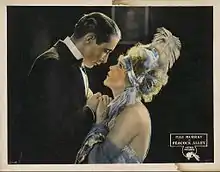| Peacock Alley | |
|---|---|
 Poster | |
| Directed by | Robert Z. Leonard |
| Written by | Edmund Goulding Robert Z. Leonard Fanny Hatton (titles) Frederic Hatton (titles) |
| Story by | Ouida Bergère |
| Produced by | Robert Z. Leonard |
| Starring | Mae Murray Monte Blue |
| Cinematography | Oliver T. Marsh |
Production company | |
| Distributed by | Metro Pictures |
Release date |
|
Running time | 80 minutes |
| Country | United States |
| Language | Silent (English intertitles) |
Peacock Alley is a 1922 American silent drama film starring Monte Blue and Mae Murray. The film was directed by Murray's husband at the time, Robert Z. Leonard.[1] An incomplete print survives at the Library of Congress.[2]

Plot
As described in a film magazine,[3] the board of directors for the main manufacturing company in the American village of Harmonville send young Elmer Harmon (Blue) to Paris to obtain a contract with the French government. In Paris Elmer meets the dancer Cleo of Paris (Murray), who casts aside her rich, would-be sweethearts and falls in love with him. When his business affairs appear hopeless, she helps him secure his contract, and the couple are married and return to Harmonville. A gala is given in Elmer's honor for having saved the village's prosperity, and citizens are shocked by Cleo's Parisian fashion. Elmer sells his interests and the couple move to New York City. To give Cleo the luxuries to which she is accustomed, Elmer in a moment of weakness forges his uncle's name and is arrested. Endeavoring to get Elmer out of trouble, Cleo returns to the stage, but in so doing she breaks a promise made to her husband. Elmer is released from jail after promising his uncle to have nothing more to do with Cleo, but then immediately tries to look her up. He finds her in what appears to be a compromising but innocent situation and decides the bad things that have been said about Cleo are true. He returns to Harmonville and the heartbroken Cleo returns to France and seeks seclusion in Normandy. Three years later Elmer finds Cleo there along with her little son who is named for him. They have a reconciliation.
Cast
- Mae Murray as Cleo of Paris
- Monte Blue as Elmer Harmon
- Edmund Lowe as Phil Garrison
- William J. Ferguson as Alex Smith (credited as W.J. Ferguson)
- Anders Randolf as Hugo Fenton (credited as Anders Randolph)
- William H. Tooker as Joseph Carleton (credited as William Tooker)
- Howard Lang as Abner Harmon
- William Frederic as Mayor of Harmontown
- M. Durant as Monsieur Dubois
- Jeffreys Lewis as Toto
- Napoleon the Dog as Napoleon
Reception
The film was one of Murray's most successful films, and one of the biggest hits of 1922. The film was so successful it was the only silent film of Murray's that she remade as the "talkie" Peacock Alley, though major changes were made to the plot.
References
- ↑ Ankerich, Michael G. (2012). Mae Murray: The Girl with the Bee-Stung Lips. University Press of Kentucky. p. 329. ISBN 978-0-813-14038-4.
- ↑ Greta, De Groat; Groat, Greta de (November 30, 2000). "Mae Murray". Stanford.edu. Retrieved October 29, 2017.
- ↑ "Reviews: Peacock Alley". Exhibitors Herald. New York City: Exhibitors Herald Company. 13 (22): 50. November 26, 1921.
External links
- Peacock Alley at IMDb
- Progressive Silent Film List: Peacock Alley at silentera.com
- Synopsis at AllMovie
- Lobby poster